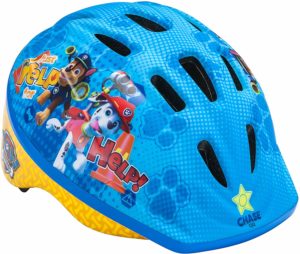
A toddler is a child between the age of 12 to 36 months old, and within this age range, the child experiences substantial growth or increase in size. This is the best time to start using a bike, and you need to get the best bike helmets for toddlers.
As a toddler, the child develops the control of large muscles which enable walking, running, jumping, and climbing, there is the ability to control small muscles.
One perfect way for toddlers to expend energy as they develop their limbs is to ride bicycles or, at least, try to learn how to.
In learning, especially in riding bicycles, safety is paramount, and to that effect, the use of helmets for toddles is non-negotiable. Kid’s bike helmets are designed to protect every vulnerable part of the head that could result either in fatalities or in long-term medical conditions if damaged.
10 Best Bike Helmets for Toddlers
Kids Bike Helmet, Adjustable and Multi-Sport, from Toddler to Youth, 3 Sizes
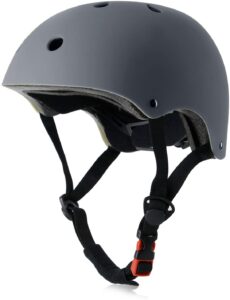
Features
- Size Small: 48-54 cm / 18.9″-21.3″
- Color Gray
- Recommended Uses For Product Cycling, Skateboarding
- Brand OUWOER
- Vehicle Service Type Scooter
The Crank adjustment dial at the back of the helmet and chin straps are adjustable to fit the user comfortably from 360 degrees. The ABS shell resists impact, and high quality EPS foam provides shock-absorbing.
It also features 11 top, and the side vents keep the user cool and comfortable. However, it is quite suitable for toddlers, kids, children and Youth and suitable for different outdoor sports such as cycling, skateboarding etc. It also comes in various attractive colors for your kids.
Pros
- Value for money
- Durability
- Lightweight
- Very comfortable
- Firm and sturdy
- It has full coverage at the back of the head
Cons
- Plain colors with no design
Giro Scamp Youth Recreational Bike Cycling Helmet
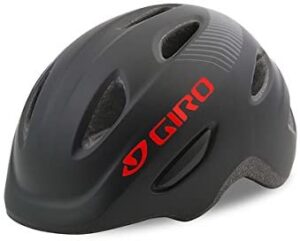
- Size X-Small (45-49 cm)
- Color Blue Splash (2021)
- Recommended Uses For Product Cycling
- Brand Giro
- Item Weight 1 Pounds
The Giro Scamp is packed with amazing features for your kids. The Roc Loc Jr. fit system with pinch-guard buckle enables the helmet to fit your kids head securely.
Moreover, your child can use this helmet as they grow from balance bikes to training wheels. However, Giro Scamp is available in a range of kid-friendly colors and designs, allowing your child to pick their favorite.
Pros
- Great Lightweight helmet
- The chin strap is easy to adjust
- It fits comfortably well
Cons
- The chin strap may be quite long and annoying
Kids Bike Helmet, GAOYU Blue Shark Kids Toddler Bike Helmet 2-6 Boy Girl Adjustable Safety Child Helmet for Cycling Skating Scooter Multi-Sport
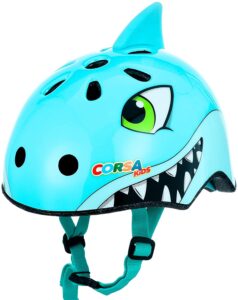
Features
- Size Small
- Color Blue
- Recommended Uses For Product Cycling
- Brand Hisyll
- Vehicle Service Type Scooter
This kids bike helmet is fully packed with safety standards, giving your child the most intimate protection. It comes with adjustable straps to ensure you achieve a better fit. Moreover, It is cool and funny looking, durable for kids and suitable for children aged 2-6.
Moreover, the toddler bike helmet is designed with 11 vents which help to reduce drag and take away excess heat to ensure breathability and comfortability during hot summer days.
Pros
- Lightweight
- Comfortable
- Sturdy
- Easy to adjust and put on
AKASO Kids Bike Helmet, Multi-Sport Toddler Helmet for Cycling Skateboard Scooter, Adjustable Child Helmet for Age 1-8
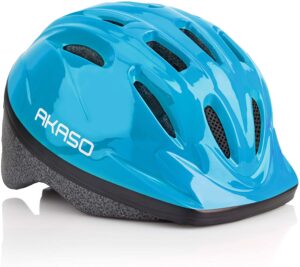
Features
- Size Small
- Color Black
- Recommended Uses For Product Cycling, Skateboarding
- Brand AKASO
- Vehicle Service Type Sport Bike, Scooter
The Akaso kids helmet provides comfort and impact resistance with a reinforced ABS shell & thickened shock-absorbing EPS core. This helmet is equipped with 14 air vents that allow ventilation and heat dissipation to keep your child’s head cool and dry and integrated bug mesh in the front vents to keep insects and other items out. In addition, the well-attached & long-lasting adjustment dial and skin-friendly adjustable chin strap maximize the best fit and comfortable wearing.
Pros
- Adjustable Fit
- Shock Absorption and Drop Resistance
- Multiple Color and Design Options
- Comfortable Sweat-absorbent Chin Pad
- Removable Inner Lining
- 14 Air Vents Allow for Ventilation and Heat Dissipation
BELL Sidetrack II MIPS Youth Bike Helmet
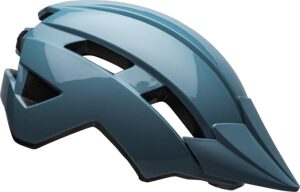
Features
- Size Universal Child (47-54 cm)
- Color Buzz Gloss Light Blue/Pink (2021)
- Recommended Uses For Product Cycling
- Brand BELL
- Vehicle Service Type Adventure Tourer
The BELL Sidetrack II, MIPS Youth Bike Helmet, features a Fusion In-mold polycarbonate shell, an integrated MIPS that reduces rotational forces resulting from certain impacts. It also features an ERGO-FIT, which has an improved dial feel and function (no longer requires a push to turn) and is sleeker and less bulky.
It also comes with quick-adjust fasteners that help keep straps flat and properly positioned. Suitable for universal Youth (47-54 cm) and universal Child (50-57 cm) Sizes; 14 vents.
Pros
- The helmet offers a removable visor
- Easily adjustable system
- Sweat guide padding
- MIPS equipped
Cons
- The inside tape may not be firm
CELOID Kids Bicycle Helmet, Adjustable Toddler Skateboard Helmet for 3-5-8year Girls Boys for Multi-Sport Road Bike Riding Skateboarding Roller Skating Scooter Rollerblade Balance Bike
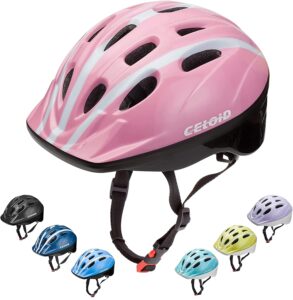
Features
- Size S(46-52cm / 18.1″-20.5″)
- Color Black
- Recommended Uses For Product Cycling, Skateboarding
- Brand CELOID
- Vehicle Service Type ATV, Scooter
The CELOID kids’ bicycle helmet is a great choice for protecting your child and toddler’s head. This kids protective gear set is adopted an anti-scratch high hardness PE shell padded with soft EVA material, safe and breathable.
It comes with high-quality liners that are both durable for many years and also breathable. In addition, it adopts ventilated fabrics to keep cool and clean while biking, cycling, riding, and skateboarding for your kid’s safety.
Pros
- It comes with shock absorption and anti-fall that ensures your kid’s safety.
- Special ventilation design
- The lining is detachable and washable
- It provides the highest level of protection
Cons
- No cons
SLANIGIRO Adult Urban Bike Helmet – Adjustable Fit System & Integrated Taillight for Men Women
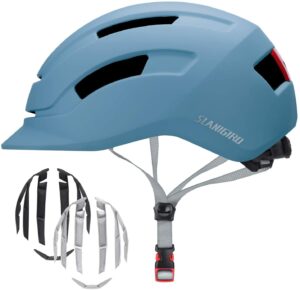
Features
- Size Medium(21.7″-22.8″/55-58cm)
- Color Matte Blue
- Recommended Uses For Product Cycling
- Brand SLANIGIRO
- Inner Material Expanded Polystyrene
The SLANIGIRO Adult Urban Bike Helmet is built for urban riders and commuters. Suitable for both men and women. Moreover, it is built using integrated construction to reduce weight.
The integrated polycarbonate shell with EPS liner enhances durability. In addition, it has 8 large vents that offer good airflow. However, It also comes with a safe rechargeable USB rear light with 3 lighting options.
Pros
- Value for money
- Lightweight
- The strap is very comfortable
- Great fit with enough ventilation
Cons
- The matte finishes can often scuff easily
P2R Kids Helmet Ventilation Adjustable Toddler Helmet Boys Girls Multi Sports Safety Cycling Skating Scooter and Other Outdoor Activities Helmet
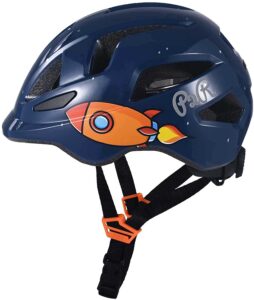
Features
- Size XS(Toddler: 2-5 years old)
- Color Sunny smile
- Recommended Uses For Product Cycling
- Brand Karrfun
- Vehicle Service Type Scooter
The Kid’s Sport Helmet is specially designed for multiple-sports head protection and an In-mould structure for durable fusion of EPS inner layer and PC outer shell. The protection layers consist of an anti-scratch extra hard PC shell for hard protection, padded with soft EPS material for impact buffering.
It has 12 vents and deep air stream channels, which offers great ventilation, reduces sweating and keeps it cool even during vigorous exercise. The straps are adjustable; It is also lightweight and convenient to wear.
Pros
- The straps are easily adjustable
- Lightweight and very convenient to wear
- It is breathable and easy to clean
- It is also durable and sturdy
Cons
- No cons
Schwinn Kids Bike Helmet with 3D Character Features, Infant and Toddler Sizes
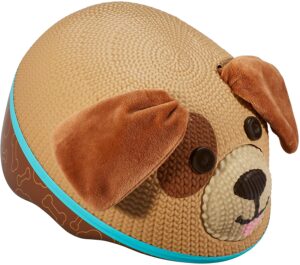
Features
- Size Infant
- Color Blue/Green
- Recommended Uses For Product Cycling
- Brand Schwinn
- Age Range (Description) Infant
The Schwinn kids feature a full coverage micro-shell for enhanced protection. In addition, the dial fit system offers 360° adjustability for the perfect custom fit, while the vented design offers airflow to keep your child cool on hot summer rides.
The cute, comfortable, and protective, the Schwinn Infant Stegosaurus helmet is the perfect way to keep your little one safe. Enjoy the freedom of riding with Schwinn.
Pros
- Lightweight
- The straps are quite easy to adjust
- Great fit
Cons
- The decorative material is pretty flimsy
Bell 7059827 3D Minnie Me Bike Helmet,Toddler (3-5 yrs.)
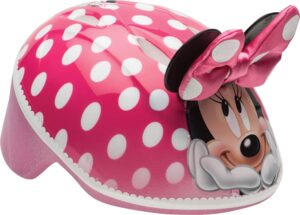
Features
- Size Toddler (3-5 yrs.)
- Color Pink
- Recommended Uses For Product Cycling
- Brand BELL
- Vehicle Service Type Street Bike
The extended rear coverage offers extra protection for your little one. At the same time, the 3D fabric bow and ears are made of non-grip material with breakaway attachment, and it is suitable for toddlers of ages 3-5 but fits most heads measuring 48-52 cm. Ensure to take the proper measurement of the head before purchasing the item
Pros
- Durability
- Lightweight
- Firm and sturdy
- Great value for money
- Great for kids and fits well
- Comfort
Cons
- The item may not be durable.
Why Bike Helmets For Toddlers?
Watching a toddler take off on a bicycle for the first time can be a wonderful experience, but can be frightening too. Fears are put allay at least to a reasonable extent by providing a bicycle helmet for the toddler.
There are so many benefits to toddlers wearing a helmet. It doesn’t only give the toddler more confidence on the bike, but also protect their heads, if or when they fall off the bike.
Falling off the bike is always expected as far as toddlers are concerned, but it’s best to keep them safe while doing this.
What Are The Best Bike Helmets For Toddlers?
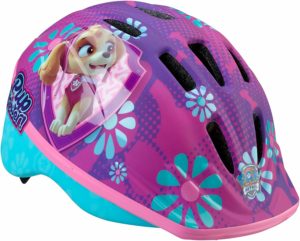
The essential features of the best bike helmets for toddlers is its ability to keep the child’s head safe. They differ in price and quality, which may be determined by brand or material used in manufacturing.
The best kid’s bike helmets also have adjustable straps that eliminate discomfort for the child. Besides, it comes with a cooling design that allows for ventilation.
Recommended Post: Best Bike for 3 Year Old
Parts of the Best Toddler Bike Helmet
The best bike helmets should have these parts. However, they are not limited to them. There might be variations based on quality and brand. Nonetheless, these are the parts of typical bike helmets for child toddler.
Shell
The shell is the visible part of a helmet and this is the layer which takes all the force on impact. It is a significant factor in the helmet’s weight, shape, and price. It can be made from various materials. Fiberglass or composite fiber, Polycarbonate, or Carbon fiber or Kevlar
Fiberglass material is one of the most popular materials used as it is hard and long-lasting. Carbon fiber or Kevlar is a robust and lightweight material. The shell of an helmet usually has a coating of paint that reflects heat for comfortability and protection.
EPS Liner
The expanded polystyrene or EPS is a thick, high-density foam that forms the second layer of the helmet. The EPS component is fitted on the inside of the shell. An equally important part of the helmet is designed to absorb all kinds of shocks- from minor to dangerous ones. It cushions the toddler’s head and adds better protection from impact.
Comfort Liner
While the shell and EPS liner protects the head, the comfort liner ensures that the helmet fits comfortably on the toddler’s head. The comfort liner can absorb sweat because of the anti-bacterial material .
One of the best benefits of the comfort liner is that it can be removed and washed when unclean or smelling. However, some helmets have moisture-wicking liners that keep them cool, dry, and clean.
Vents
The vents in a helmet allow ventilation while the rider is wearing it. The vents are typically found on the chin bar, at the back of the helmet and over the brow.
Most helmets usually have two kinds of vents:
- Forward-facing vents- Help bring the air in
- Rear-facing or exhaust vents- Push warm air out
Some helmets are made with adjustable vents or the ones that can be closed to control the airflow in cold weather.
Visor
The visor is the movable (slides up and down) shield that protects the front of the toddler’s, including the eyes from dust and harsh sunlight.
Some helmets also have tinted visors that protect the rider’s eyes from ultraviolet rays. At the same time, some of the newer designs feature anti-fogging technology that enables riders to ride in rain or fog without affecting their visibility.
Some of the best durable visors are made of polycarbonate material, which hardly breaks or shatter on impact.
Retention or Closure System
The retention system includes the chin strap that helps to keep the helmet in place on your head when riding. The closure system usually seen in helmets is the D ring system, wherein the chin strap is looped around two D rings.
Things to Consider In Purchasing the Best Bike Helmets for Toddlers
The best bike helmets for toddlers may vary, but there are essential things to consider while purchasing bike helmets for toddlers.
Materials
This plays a significant role in the quality of the bike helmet. It also determines the helmet’s shape, weight, and price.
Materials used in making helmet include fiberglass or composite fiber, polycarbonate and carbon fiber or Kevlar.
Fiberglass is one of the most popular materials used as it is hard and long-lasting. Carbon fiber or Kevlar is a robust and lightweight material. The shell often has a coating of paint that reflects heat to ensure that it is not only protective but comfortable as well.
Reviews
Reading reviews about the bike helmets to buy is essential as it will help you make an informed decision on the helmet to be purchased for the toddlers.
Frequently Asked Questions
How Do You Measure a Child’s Head for Helmet?
You can use a tape to measure the circumference of their head. Measure from one inch above their eyebrows (the thickest part of their head). Find a helmet that includes this number in its size range.
Hi, the Best Bike Helmets for Toddlers in 2020: Expert Review article it is well written, it’s very informative.